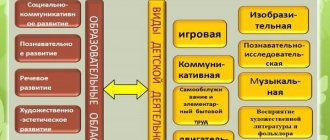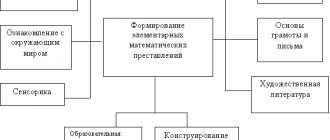Presentation “Information technologies in kindergarten”
Faith to the Vizier
Presentation “Information technologies in kindergarten”
technical devices around him almost from birth ; they are very attractive to the child. Society lives in a world of constant multiplication of information , constant invention of devices for processing this information . A computer helps a person solve practical problems.
Slide No. 2
The “tomorrow” of today’s children is the information society . And the child must be psychologically prepared for life in the information society . Computer literacy is now becoming necessary for every person.
Therefore, a preschool educational institution, as a carrier of culture and knowledge, also cannot remain on the sidelines. We must keep up with the times and become a child’s guide to the world of new technologies .
We are talking about the use of information and communication technologies (ICT)
teachers to improve the efficiency of the educational process.
Slide No. 3
ICT means the use of a computer, the Internet, television, video, DVD, CD, multimedia, audiovisual equipment, that is, everything that can provide ample opportunities for the cognitive development of a child.
Slide No. 4
The main goal of introducing information technologies is to create a unified educational institution space, a system in which all participants in the educational process - administration, teachers, students, parents - are involved and connected the information
ICT competencies of a teacher will improve the professional level of a teacher, significantly improve the quality of education at educational institutions, and increase the prestige of the institution in the eyes of parents and the public.
Slide No. 5
Where can ICT help a teacher in his work?
The areas of application of ICT by preschool teachers are enormous.
1. Maintaining documentation.
In the preparation and execution of calendar and long-term plans, in the preparation of material for the design of the parent’s corner, in conducting diagnostics and preparing it in printed and electronic form.
An important aspect of the use of ICT is the preparation of teachers for certification. Here you can consider both the preparation of documentation and the preparation of an electronic portfolio.
2. Methodological work, teacher training.
In the information society, networked electronic resources are the most convenient, fastest and most modern way to share new methodological ideas and manuals, and your experience, regardless of where you live.
There is an opportunity to participate in various pedagogical projects, distance competitions, quizzes, olympiads, which increases the level of self-esteem of both the teacher and the students (child)
Slide No. 6-7-8
3. Educational process.
The introduction of information technologies has advantages over traditional means of teaching:
1. ICT makes it possible to expand the use of electronic learning tools, as they transmit information faster .
2. Movements, sound, animation attract children's attention for a long time and help increase their interest in the material being studied. The high dynamics of the lesson contributes to the effective assimilation of material, the development of memory, imagination, and creativity of children.
3. Provides clarity, which contributes to the perception and better memorization of material, which is very important, given the visual-figurative thinking of preschool children. In this case, three types of memory are included: visual, auditory, motor.
4. Slideshows and video clips allow you to show those moments from the surrounding world that are difficult to observe: for example, the growth of a flower, the rotation of planets around the Sun, the movement of waves, it’s raining.
5. You can also simulate life situations that are impossible or difficult to show and see in everyday life (for example, reproducing the sounds of nature; the operation of transport, etc.)
.
6. The use of information technology encourages children to search for research activities, including searching the Internet independently or together with their parents;
7. ICT is an additional opportunity to work with children with disabilities.
Slide No. 9-10
Recognizing that the computer is a new powerful tool for the development of children, it is necessary to remember the commandment “DO NO HARM!”
.
The use of ICT in preschool institutions requires careful organization of both the classes themselves and the entire regime as a whole in accordance with the age of the children and the requirements of the Sanitary Rules. (SanPiN 2.4.1.2660-10)
• Classes using a computer should be conducted with preschoolers 5-7 years old no more than 3 times a week for 10-15 minutes no more than 1 time a day. After classes, do eye exercises
•It is necessary to ensure rational organization of the workplace: furniture that matches the child’s height, a sufficient level of illumination.
• The video monitor screen should be at the child’s eye level at a distance of no closer than 50 cm.
• It is better to choose a monochromatic background for presentations that does not distract attention from the content of the slide, calm colors that do not irritate the eyesight. You can change it several times during the presentation . This will keep children's involuntary attention.
• Illustrations should be large and realistic, not overloaded with unnecessary details. It is unacceptable to use blurry photographs, as well as images that can cause fear or hostility in children.
• Don't overload your presentation with special effects . Moderate use of special effects helps to keep attention on the computer screen, increases interest, and creates a positive emotional mood, but excessive use of them leads to the opposite effect.
Today, many kindergartens are equipped with computer classes. But they are still missing:
• methods of using ICT in the educational process of preschool educational institutions;
• systematization of computer development programs;
• unified program and methodological requirements for computer classes.
Today, this is the only type of activity that is not regulated by a special educational program. Teachers have to independently study the approach and implement it in their activities.
Slide number 11
My small experience of using ICT in teaching preschoolers allows me to conclude that these are inexhaustible opportunities for the comprehensive development of a child’s personality, creativity and talent. Such activities cannot be boring or uninteresting for children, and the use of ICT further develops interest in cognitive activity.
Thus, I would like to emphasize once again that modern computer technologies allow a child to express himself and reveal his capabilities more widely within the framework of mastering educational programs.
MAGAZINE Preschooler.RF
Presentation: ICT in the process of adaptation, training and development of learning for children of early and early preschool ageTeacher of the Municipal Preschool Educational Institution "Kindergarten No. 53" of the city of Novosibirsk Oksana Mikhailovna Bukhtiyarova
The use of information technologies is driven by the social need to improve the quality of upbringing and education of young children. Modern children are different from previous generations; information technology enters children's lives very early. And the power of their influence on the child’s psyche is great. The use of this technology requires both new skills and knowledge from the teacher: finding the necessary information in the information space of the Internet, making presentations, including interactive games in GCD, etc.
The goal is to improve the quality of the educational process in working with young children
Tasks:
- To increase the competence of all participants in the educational process in implementing ICT in the upbringing and education of young children.
- Systematize effective methods and techniques of working with the use of ICT in the education of young children in
- Create an ICT resource base through file cabinets by section
- Select material that is bright, imaginative and in an accessible form, with the implementation of didactic principles in working with young children
- Include all participants in the educational process using ICT.
I would like to share in practice methods and techniques that I find interesting.
1) the Sinkwine is used as a method for developing active speech, allowing you to quickly get results. The syncwine algorithm is similar to a ladder. The basic rules for compiling a syncwine include the following:
- line – one keyword (in our example, this is Car)
- line – two words a sign of an object (small, red)
- line - three words action (stands, rides, play)
- line – four words – sentence (the red typewriter is on the table)
- line - one word - summary (typewriter)
- “Storytelling” method is a pedagogical technique built on the use of stories with a specific structure and an interesting character, which is aimed at resolving pedagogical issues in education. The goal of storytelling is to capture children’s attention from the beginning of the story and hold it throughout the story, to arouse sympathy for the hero, and to convey the main idea of the story. Let's look at our example: Guys, look, I met a girl who was crying, but let's see why she's crying and start building a story together with the children.
- Next, I want to show on the slide the use of ICT using the example of direct educational activities on the topic “Pets”
Goal: To introduce children of the early development group to a new form of classes; increasing the efficiency of the educational process through ICT.
On this slide we see a multisensory effect on several analyzers at once: hearing, vision, kinesthetics, which contributes to more complete, faster and high-quality memorization and perception of an object or subject.
I suggest that children look at the picture “Pets” in a Microsoft Power Point presentation. Name the animals that are present in the picture. Next, I suggest listening to the real sounds that these animals make, then asking the children to match the sounds of the animals and repeat, which promotes the development of speech and hearing.
The influence of gadgets on the visual analyzer should be taken into account; due to the visual perception of a flashing screen, the mucous membrane of the eye dries out. I do gymnastics for the eyes: “Close your eyes, bat your eyelashes, rest your eyes .
Gymnastics for the eyes with the appearance of a butterfly, following its movement, also relieves tension from the visual analyzer.
With the help of presentations, I teach children exercises to relieve visual fatigue and visual gymnastics complexes. For example, I suggest looking at the slide: night has fallen (quiet, relaxing music is playing). Children perform the actions in question: eye exercises “Night” :
It's dark outside, night has fallen. We need to close our eyes. One, two, three You can open our eyes.
Again we count to three, close our eyes again. One, two, three We open our eyes.
Using the Power Point program I create a didactic game. I conduct the lesson in a playful way. Let's take a look at this game.
Didactic game “Who is the odd one out” (I invite the children to name the animals and where they live).
Didactic game “Who eats what?”
There is a hare in the picture, I invite the children to name each product and guess what a hare is. Guys, do you have a bunny tomato? Correctly not (mouse click and the tomato disappears, etc.).
Using such exercises, children get a more complete, real understanding of their surroundings, without spending a lot of time in front of the projector. I believe that the use of ICT makes it possible to most successfully and fully realize the development of children, as well as increase the efficiency of the educational process.
In conclusion, I would like to add that ICT helps to interest and activate children not only cognitively, but also in speech, which is very important for our children. Computer technologies do not replace traditional games and activities, but complement them, enriching the pedagogical process with new opportunities.
| Next > |




